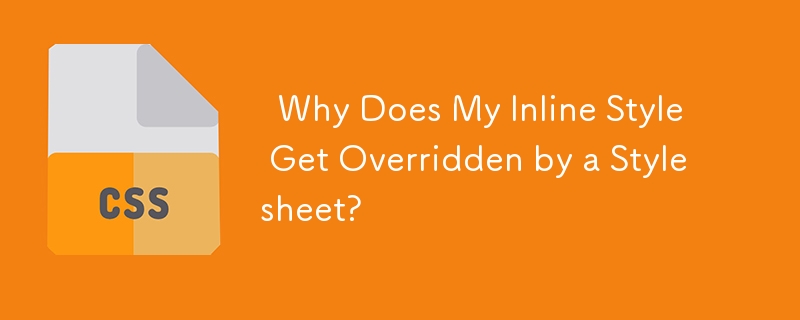Why Does My Inline Style Get Overridden by a Stylesheet?

CSS Specificity: Ruling the Styling Hierarchy
In the world of web development, understanding CSS precedence is crucial to effectively manage conflicting styles. Consider the following scenario: a webpage contains both inline styling and a referenced stylesheet, but the stylesheet appears to override the inline styling.
This precedence issue arises due to the concept of CSS specificity. CSS assigns a numerical value to each style declaration based on the length and specificity of its selector. The higher the value, the greater the specificity, and the more likely it is to override other styles.
In the given example, the CSS provided is as follows:
<style>
td {
padding-left:10px;
}
</style>and
.rightColumn * {margin: 0; padding: 0;}The inline style declaration for td has a specificity of 0001 (zero ID attributes, zero class or attribute selectors, and one element name). The stylesheet declaration for .rightColumn * has a specificity of 0010 (zero ID attributes, one class selector, zero attribute or pseudo-class selectors, and zero element names).
According to CSS specificity rules, the latter declaration has a higher specificity and therefore takes precedence, even though it comes earlier in the source order.
To overcome this issue, there are two options:
- Use !important: Add !important to the td style declaration to make it more important than the stylesheet rule. However, using !important can be problematic if there are many conflicting rules.
- Increase the Specificity of the Inline Style: Increase the specificity of the td selector by adding an ID or class to it. This will give the inline style a higher specificity than the stylesheet rule, allowing it to override it.
For example:
<style>
.important-td {
padding-left:10px;
}
</style>or
<style>
#specific-td {
padding-left:10px;
}
</style>Understanding CSS specificity is essential for effective web design and ensuring that the styles applied to your elements are as intended. By leveraging the concept of specificity, developers can prioritize styles and create the desired visual appearance for their web pages.
The above is the detailed content of Why Does My Inline Style Get Overridden by a Stylesheet?. For more information, please follow other related articles on the PHP Chinese website!

Hot AI Tools

Undresser.AI Undress
AI-powered app for creating realistic nude photos

AI Clothes Remover
Online AI tool for removing clothes from photos.

Undress AI Tool
Undress images for free

Clothoff.io
AI clothes remover

AI Hentai Generator
Generate AI Hentai for free.

Hot Article

Hot Tools

Notepad++7.3.1
Easy-to-use and free code editor

SublimeText3 Chinese version
Chinese version, very easy to use

Zend Studio 13.0.1
Powerful PHP integrated development environment

Dreamweaver CS6
Visual web development tools

SublimeText3 Mac version
God-level code editing software (SublimeText3)

Hot Topics
 1377
1377
 52
52
 Working With GraphQL Caching
Mar 19, 2025 am 09:36 AM
Working With GraphQL Caching
Mar 19, 2025 am 09:36 AM
If you’ve recently started working with GraphQL, or reviewed its pros and cons, you’ve no doubt heard things like “GraphQL doesn’t support caching” or
 Making Your First Custom Svelte Transition
Mar 15, 2025 am 11:08 AM
Making Your First Custom Svelte Transition
Mar 15, 2025 am 11:08 AM
The Svelte transition API provides a way to animate components when they enter or leave the document, including custom Svelte transitions.
 Show, Don't Tell
Mar 16, 2025 am 11:49 AM
Show, Don't Tell
Mar 16, 2025 am 11:49 AM
How much time do you spend designing the content presentation for your websites? When you write a new blog post or create a new page, are you thinking about
 Building an Ethereum app using Redwood.js and Fauna
Mar 28, 2025 am 09:18 AM
Building an Ethereum app using Redwood.js and Fauna
Mar 28, 2025 am 09:18 AM
With the recent climb of Bitcoin’s price over 20k $USD, and to it recently breaking 30k, I thought it’s worth taking a deep dive back into creating Ethereum
 What the Heck Are npm Commands?
Mar 15, 2025 am 11:36 AM
What the Heck Are npm Commands?
Mar 15, 2025 am 11:36 AM
npm commands run various tasks for you, either as a one-off or a continuously running process for things like starting a server or compiling code.
 How do you use CSS to create text effects, such as text shadows and gradients?
Mar 14, 2025 am 11:10 AM
How do you use CSS to create text effects, such as text shadows and gradients?
Mar 14, 2025 am 11:10 AM
The article discusses using CSS for text effects like shadows and gradients, optimizing them for performance, and enhancing user experience. It also lists resources for beginners.(159 characters)
 Creating Your Own Bragdoc With Eleventy
Mar 18, 2025 am 11:23 AM
Creating Your Own Bragdoc With Eleventy
Mar 18, 2025 am 11:23 AM
No matter what stage you’re at as a developer, the tasks we complete—whether big or small—make a huge impact in our personal and professional growth.
 Let's use (X, X, X, X) for talking about specificity
Mar 24, 2025 am 10:37 AM
Let's use (X, X, X, X) for talking about specificity
Mar 24, 2025 am 10:37 AM
I was just chatting with Eric Meyer the other day and I remembered an Eric Meyer story from my formative years. I wrote a blog post about CSS specificity, and




